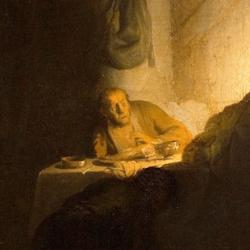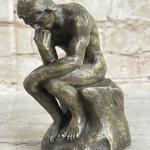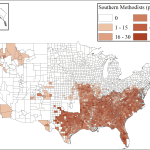In her meticulous and revealing study of The Eucharist in the Reformation, Lee Palmer Wandel argues that Luther and Zwingli divided at Marburg because their respective positions were incommensurate, incomprehensible each to the other. Specifically, they “divided over the nature of Christ’s body,” but that point of division represented radically different conceptions of body, matter, and God’s relation to creation.
Zwingli insisted that “Christ’s body could not be corporeally present in every morsel of bread; indeed it horrified him to think of human beings taking Christ’s physical body into their mouths and grinding it between their teeth.” The bread must be a sign, else Christ’s body ceases to be a human body by becoming ubiquitous, “spread all over simultaneously” (102).
Wandel emphasizes that Zwingli taught a “sacramental” presence (Gegenwart) in the Supper; but the presence was not a bodily one. This was not, she insists elsewhere, a merely mental presence: “For Zwingli, Christ’s ‘representative’ presence in the Eucharist was visceral — even as it was not that body Luther held necessary.”
Luther rejected this conception as an effort to “subsume the Words of God to human sensibility and human reason.” Matter is not independent of God; it can be and do what God wants it to be and do. Joined to the eternal Word, the body of Jesus was not like other bodies. Zwingli’s position not only raised questions about the power of God over His creation, but it undermined confidence in the promise of God by creating a caesura between the hoc and the corpus meum. The relationship cannot be “figural, tropaic, metaphorical, symbolic or in any way representative” because it had to be a real presence.
Here is one perhaps surprising result of Wandel’s account: Zwingli attributed greater power to signs than Luther. For Luther, symbolic presence – non-corporeal presence – was unreal. For Zwingli, presence could be real in some way even though symbolic.
Elsewhere, Wandel has examined Zwingli’s conception of matter at some length (in a contribution to Image and the Imagination of the Religious Self in Late Medieval and Early Modern Europe, available as a separate article at ResearchGate.net). For Zwingli, physicality is of the essence of human nature, and because human beings are physical and bodily, we have immediate attachment to sensible things. Wandel writes that for “Zwingli, human beings are, by their ‘nature,’ drawn to what they can see, hear, smell, touch, taste. By their nature, they are drawn, in other words, to matter. The reason, as he suggests here, is not some simple Manichaeism, again a caricature that seems to have stuck, but a sense of the material world’s accessibility.”
Human beings thus place greater value on material things than they deserve: “That accessibility is the beginning of a process in which ‘images and visible things’ acquire greater cognitive value, greater meaning, such that ‘man holds them to be themselves holy,’ and ultimately, comes to ‘seek from them what should be sought from God alone’. Zwingli does not argue that images either are understood to replace or are mistaken for God. As he describes here, their materiality draws human attention, then devotion, then ‘what should be sought from God alone.’”
Idols are the product of a complex interplay of mind and matter. Not matter per se, but material representations are dangerous because “Human beings — Zwingli’s word here is ‘make’ — attribute values to the image or likeness that do not inhere in the image or likeness itself. The transformation of an image into an idol operates not at the perceptual or rational level, but at the psychological and emotional.”
Zwingli doesn’t speak of matter as “seductive.” Rather, the source of idolatry is the human heart; like Calvin, he sees the heart as a “veritable factory of idols.” As Zwingli wrote in 1525, “for us the images and visible things increase more and more, becoming ever greater and greater, until at last man holds them to be themselves holy and begins to seek from them what should be sought from God alone. For this reason has he forbidden the images of God.” Further, he defined an idol as “an image [bildnus] of a helper or consolation [trosthuffens], or that to which honour is done; we call images [bilder], however, likenesses of anything which is visible, but which is not made into any misleading hope or honoured.”
The bread of the Supper is not an idol because it is a designated site of communion with God. But the interplay of matter and mind works the same in the Supper as in idolatry: “While only the bread was substantially present – no corporeal presence of Christ – that bread, nonetheless, was both itself visible and tangible, accessible to the human body, and also, through the operation of human nature, something that could be accorded value or trust. It could, following Zwingli’s sense of human psychology, be connected in the mind to the body of Christ, and that connection was not simply ‘spiritual’ or even, in the modern language, psychological, but visceral.
. . . It was a site, a material site, of connection to Christ’s body, through a complex cognitive process.”On Wandel’s reading, Luther saw less inherent potency in matter than Zwingli did. Matter had no agency of its own; it simply is what God wills it to be. Further, Luther was more or less indifferent to the material culture of medieval piety, retaining much of the stuff and many of the gestures and adornments of the Mass. The stripped-bare churches of the Swiss Reformation are testimony, she argues, not to Zwingli’s belittling of matter but to his anxiety about its potency.













